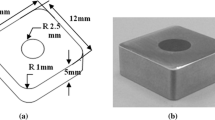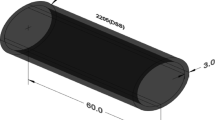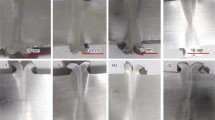Abstract
To avoid defect formation, a two-step forging process for duplex fork was developed and optimized using an unequal thickness flash. The large cross-sectional difference between the different parts of the complex shape of the duplex fork made it difficult to forge. Crack defects formed during initial forging were observed and analyzed by finite element simulation, and the metal flow lines and velocity distributions on the main cross section were studied. A non-uniform velocity distribution with a large difference in the dangerous area and large amount of oxide scale most likely caused the crack defects. An optimized two-step forging process was developed, preupsetting was used to remove the oxide scale, and final forging using a die with an unequal flash gutter depth was used to obtain a reasonable velocity distribution. The effect of different process parameters on the optimized forging process was determined. The parameters included the pre-upsetting stroke, the friction factor, the workpiece mass, and the offset of the preform, and the results were used to improve the process stability. A duplex fork of acceptable quality and without any cracks was forged in successful trial production using the optimized process in the forging plant.
Similar content being viewed by others
References
Bulut, G. and Parlar, Z., “Dynamic Stability of a Shaft System Connected through a Hooke's Joint,” Mechanism and Machine Theory, Vol. 46, No. 11, pp. 1689–1695, 2011.
Khalilpourazary, S., Dadvand, A., Azdast, T., and Sadeghi, M. H., “Design and Manufacturing of a Straight Bevel Gear in Hot Precision Forging Process using Finite Volume Method and CAD/CAE Technology,” The International Journal of Advanced Manufacturing Technology, Vol. 56, No. 1-4, pp. 87–95, 2011.
Zhang, Y., Shan, D., and Xu, F., “Flow Lines Control of Disk Structure with Complex Shape in Isothermal Precision Forging,” Journal of Materials Processing Technology, Vol. 209, No. 2, pp. 745–753, 2009.
Kim, J.-B., Seo, W.-S., and Park, K., “Damage Prediction in the Multistep Forging Process of Subminiature Screws,” Int. J. Precis. Eng. Manuf., Vol. 13, No. 9, pp. 1619–1624, 2012.
Duan, X. and Liu, J., “Research on Damage Evolution and Damage Model of 316LN Steel during Forging,” Materials Science and Engineering: A, Vol. 588, pp. 265–271, 2013.
Rao, A. V. and Ramakrishnan, N., “A Comparative Evaluation of the Theoretical Failure Criteria for Workability in Cold Forging,” Journal of Materials Processing Technology, Vol. 142, No. 1, pp. 29–42, 2003.
Arentoft, M., Henningsen, P., Bay, N., and Wanheim, T., “Simulation of Defects in Metal Forming-An Example,” Journal of Materials Processing Technology, Vol. 45, No. 1, pp. 527–532, 1994.
Joun, M. S., Lee, S. W., and Chung, J. H., “Finite Element Analysis of a Multi-Stage Axisymmetric Forging Process Having a Spring-Attached Die for Controlling Metal Flow Lines,” International Journal of Machine Tools and Manufacture, Vol. 38, No. 7, pp. 843–854, 1998.
Abdullah, A. B., Sapuan, S. M., Samad, Z., Khaleed, H. M. T., and Aziz, N. A., “Numerical Investigation of Geometrical Defect in Cold Forging of an AUV Blade Pin Head,” Journal of Manufacturing Processes, Vol. 15, No. 1, pp. 141–150, 2013.
Matsumoto, R., Osumi, Y., and Utsunomiya, H., “Reduction of Friction of Steel Covered with Oxide Scale in Hot Forging,” Journal of Materials Processing Technology, Vol. 214, No. 3, pp. 651–659, 2014.
Daouben, E., Dubois, A., Dubar, M., Dubar, L., Deltombe, R., et al., “Effects of Lubricant and Lubrication Parameters on Friction during Hot Steel Forging,” International Journal of Material Forming, Vol. 1, No. 1, pp. 1223–1226, 2008.
Torres, M. n. and Colás, R., “A Model for Heat Conduction through the Oxide Layer of Steel during Hot Rolling,” Journal of Materials Processing Technology, Vol. 105, No. 3, pp. 258–263, 2000.
Suarez, L., Rodriguez-Calvillo, P., Houbaert, Y., Garza-Montes-de-Oca, N. F., and Colas, R., “Analysis of Deformed Oxide Layers Grown on Steel,” Oxidation of Metals, Vol. 75, No. 5-6, pp. 281–295, 2011.
Scarabello, D., Ghiotti, A., and Bruschi, S., “FE Modelling of Large Ingot Hot Forging,” International Journal of Material Forming, Vol. 3, No. 1, pp. 335–338, 2010.
Li, Y. H. and Sellars, C. M., “Comparative Investigations of Interfacial Heat Transfer Behaviour during Hot Forging and Rolling of Steel with Oxide Scale Formation,” Journal of Materials Processing Technology, Vol. 80, No. pp. 282–286, 1998.
Kchaou, M., Elleuch, R., Desplanques, Y., Boidin, X., and Degallaix, G., “Failure Mechanisms of H13 Die on Relation to the Forging Process-A Case Study of Brass Gas Valves,” Engineering Failure Analysis, Vol. 17, No. 2, pp. 403–415, 2010.
Chavoshi, S. Z., Tajdari, M., and Luo, X., “An Investigation into the Effect of Variable Flash Thickness on the Strength of an AA7075 Part Obtained by Hot Closed-Die Forging,” Proceedings of the Institution of Mechanical Engineers, Part C: Journal of Mechanical Engineering Science, DOI No. 10.1177/0954406214540284, 2014.
Grass, H., Krempaszky, C., and Werner, E., “3-D FEM-Simulation of Hot Forming Processes for the Production of a Connecting Rod,” Computational Materials Science, Vol. 36, No. 4, pp. 480–489, 2006.
Zhang, Y.-J., Hui, W.-J., and Dong, H., “Hot Forging Simulation Analysis and Application of Microalloyed Steel Crankshaft,” Journal of Iron and Steel Research, International, Vol. 14, No. 5, pp. 189–194, 2007.
Tomov, B., Radev, R., and Gagov, V., “Influence of Flash Design upon Process Parameters of Hot Die Forging,” Journal of Materials Processing Technology, Vols. 157-158, pp. 620–623, 2004.
Author information
Authors and Affiliations
Corresponding author
Rights and permissions
About this article
Cite this article
Hu, C., Zeng, F., Zhao, Z. et al. Process optimization for design of duplex universal joint fork using unequal thickness flash. Int. J. Precis. Eng. Manuf. 16, 2517–2527 (2015). https://doi.org/10.1007/s12541-015-0323-7
Received:
Revised:
Accepted:
Published:
Issue Date:
DOI: https://doi.org/10.1007/s12541-015-0323-7




